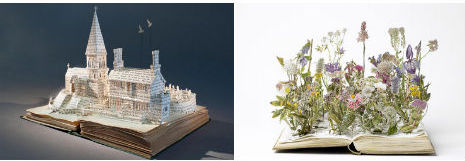|
It is difficult to get the news from poems yet men die miserably every day for lack of what is found there. - from Asphodel, That Greeny Flower by William Carlos Williams |
||
They're often short enough to accompany your morning coffee, and light enough to carry around in your pocket. They can be funny, powerful, sad, wistful, sexy, angry, or silly. With to-the-quick immediacy and just a handful of words, a poem can strike a place in the reader that most tomes could only aspire to. The first step to reading poetry is finding a poem you love, and I think collections are the best place to start, mostly because you increase your odds with so many poets between the covers.
The following are my favorite collections because they're curated with personality and passion, not obligation to the canon. So wrestle poetry away from the grasp of your stuffy high-school English teacher, forget all the rules, and add a poem to your daily news.
The New York Times reviewed Rebecca Hunt's novel, Mr. Chartwell, in the Sunday Book Review on March 13. Since I reviewed the book for BookBrowse not long ago, I was interested to see what the Times thought of it. (My review is only available to BookBrowse members at this time. Here's a PDF of it for those who are not members.)
Tadzio Koelb's review took a snarky tone from the start, and not just in reference to Mr. Chartwell, but to readers in general (who are apparently too stupid to know what good books are). My blood didn't really start to boil, however, until Mr. Koelb condescended to reveal the obvious truth about Rebecca Hunt's novel, the glaring fact that those of us who liked the book sadly missed:
 All 42 of Mary Higgins Clark's books to date have been bestsellers, she's spent a collective 355 weeks on the New York Times best-seller lists, sold more than 100 million copies in the USA, and many more millions across the other 33 countries where her books are sold, including 24 million in France. Her latest book, publishing in time for Mother's Day, is predicted to sell at least 3.5 million copies.
All 42 of Mary Higgins Clark's books to date have been bestsellers, she's spent a collective 355 weeks on the New York Times best-seller lists, sold more than 100 million copies in the USA, and many more millions across the other 33 countries where her books are sold, including 24 million in France. Her latest book, publishing in time for Mother's Day, is predicted to sell at least 3.5 million copies.
But Ms Clark and her publisher now face a quandary. At 83 years of age, the doyenne of the wholesome thriller (no unmarried couples living together, no swearing and no graphic scenes), who collected 40 rejection slips before her first story was published in 1956, is facing the question of how to maintain her brand in the "twilight of her career" (as The Wall Street Journal puts it) and after she's gone. The same question must be very much top of mind for her publisher, Simon & Schuster, who've been able to rely on their top-selling author to help keep them in the black for many a year.
I can't see the appeal in taking a daily photo of myself just to see the face sagging and the wrinkle lines deepen but, especially when our children were younger, I would have loved this iPhone App that prompts you to take a photo every day and then builds a time-lapse video montage. If you used the prompt to not just take a photo but write a few words it could quickly build into a powerful and remarkably painless journal!
Weburbanist have collected some stunning examples of books used in art and architecture,
From the creative:

Su Blackwell coaxes life from the pages of a book, not through vivid descriptions but through very precise cuts: "I often work within the realm of fairy-tales and folk-lore. I began making a series of book-sculpture, cutting-out images from old books to create three-dimensional diorama's, and displaying them inside wooden boxes".
NPR commentator Andrei Codrescu is upset that passages on his Kindle ebook reader are, all of a sudden, turning up pre-highlighted:
"I'm reading a new book I downloaded on my Kindle and I noticed an underlined passage. It is surely a mistake, I think. This is a new book. I don't know about you, but I always hated underlined passages in used books.... And then I discovered that the horror doesn't stop with the unwelcomed presence of another reader who's defaced my new book. But it deepens with something called view popular highlights, which will tell you how many morons have underlined before so that not only you do not own the new book you paid for, the entire experience of reading is shattered by the presence of a mob that agitates inside your text like strangers in a train station..." (listen to the full 3 minute broadcast, read the transcript)